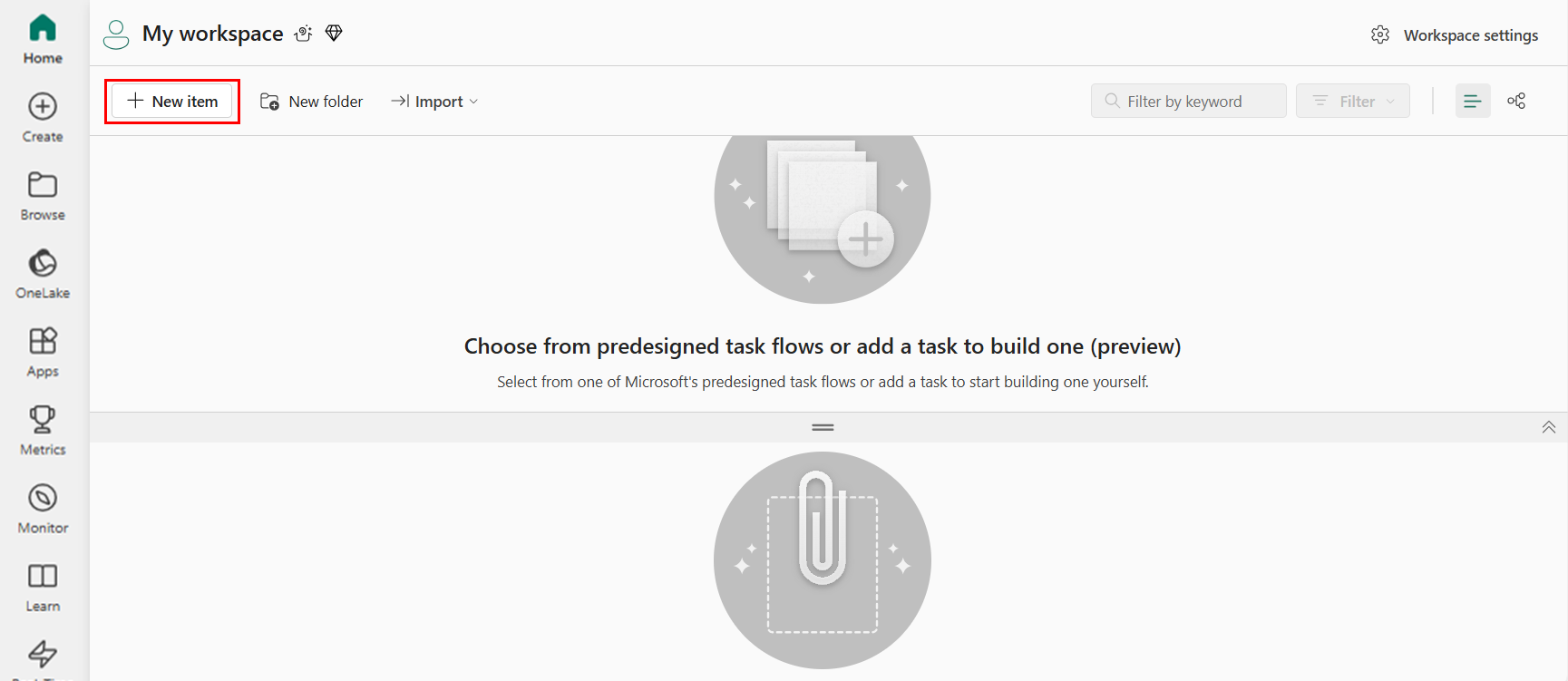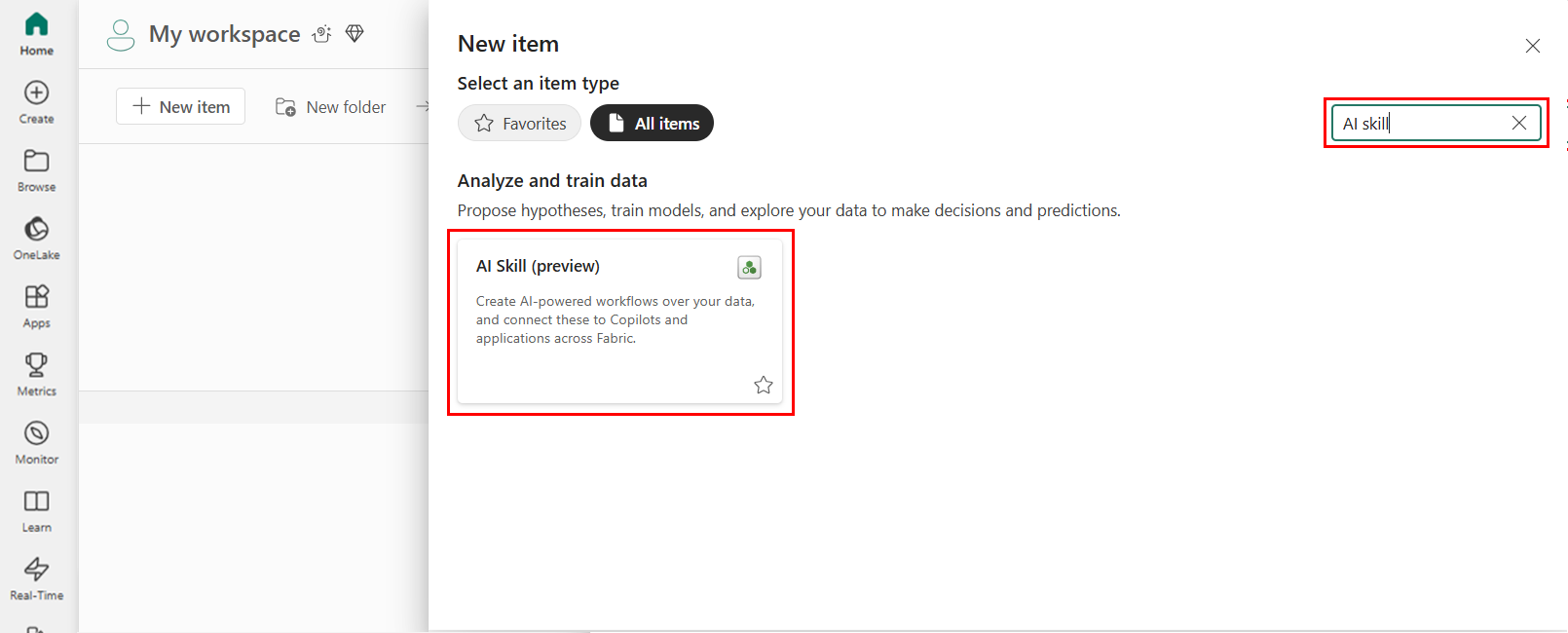AI skill example with the AdventureWorks dataset (preview)
This article shows how to configure an AI skill on the AdventureWorks dataset.
Important
This feature is in preview.
Prerequisites
- A paid F64 or higher Fabric capacity resource.
- AI skill tenant switch is enabled.
- Copilot tenant switch is enabled.
- Cross-geo sharing for AI is enabled, if relevant.
Create a lakehouse with AdventureWorksDW
First, create a lakehouse and populate it with the necessary data.
If you already have an instance of AdventureWorksDW in a warehouse or lakehouse, you can skip this step. If not, create a lakehouse from a notebook. Use the notebook to populate the lakehouse with the data.
Create a new notebook in the workspace where you want to create your AI skill.
On the left side of the Explorer pane, select + Data sources. This option adds an existing lakehouse or creates a new lakehouse.
In the top cell, add the following code snippet:
import pandas as pd from tqdm.auto import tqdm base = "https://synapseaisolutionsa.blob.core.windows.net/public/AdventureWorks" # load list of tables df_tables = pd.read_csv(f"{base}/adventureworks.csv", names=["table"]) for table in (pbar := tqdm(df_tables['table'].values)): pbar.set_description(f"Uploading {table} to lakehouse") # download df = pd.read_parquet(f"{base}/{table}.parquet") # save as lakehouse table spark.createDataFrame(df).write.mode('overwrite').saveAsTable(table)Select Run all.
After a few minutes, the lakehouse is populated with the necessary data.
Create an AI skill
To create a new AI skill, first select New item, as shown in this screenshot:
At the next screen, type AI skill in the upper right text box, and select the AI Skill (preview) at the left, as shown in this screenshot:
Enter a name to create an AI skill, and select Create.
Select the data
Select the lakehouse you created and select Connect. You must then select the tables for which you want the AI skill to have available access.
This exercise uses these tables:
DimCustomerDimDateDimGeographyDimProductDimProductCategoryDimPromotionDimResellerDimSalesTerritoryFactInternetSalesFactResellerSales
Provide instructions
When you first ask the AI skill questions with the listed tables selected, the AI skill answers them fairly well. For instance, for the question What is the most sold product?, the AI skill returns:
Long-Sleeve Logo Jersey, L
However, the SQL query needs some improvement. First, it only looks at the FactResellerSales table. It ignores the FactInternetSales table. Second, it orders the products by order quantity, when total sales revenue associated with the product is the most important consideration, as shown in this screenshot:
To improve the query generation, provide some instructions, as shown in these examples:
- Whenever I ask about "the most sold" products or items, the metric of interest is total sales revenue and not order quantity.
- The primary table to use is
FactInternetSales. Only useFactResellerSalesif explicitly asked about resales or when asked about total sales.
Asking the question again returns a different answer, Mountain-200 Black, 46, as shown in this screenshot:
The corresponding SQL draws from the FactInternetSales table, and it sorts by the sum of the sales amount. The AI followed the instructions.
As you continue to experiment with queries, you should add more instructions.
This scenario uses the following set of instructions:
- Whenever I ask about "the most sold" products or items, the metric of interest is sales revenue and not order quantity.
- The primary table to use is
FactInternetSales. Only useFactResellerSalesif explicitly asked about resales or when asked about total sales. - When asked about the impact of promotions, do so on the increase in sales revenue, not just the number of units sold.
- For customer insights, focus on the total sales amount per customer rather than the number of orders.
- Use
DimDateto extract specific time periods (for example, year, month) when performing time-based analysis. - When analyzing geographical data, prioritize total sales revenue and average sales per order for each region.
- For product category insights, always use
DimProductCategoryto group products accordingly. - When comparing sales between regions, use
DimSalesTerritoryfor accurate territory details. - Use
DimCurrencyto normalize sales data if analyzing sales in different currencies. - For detailed product information, always join
FactInternetSaleswithDimProduct. - Use
DimPromotionto analyze the effectiveness of different promotional campaigns. - For reseller performance, focus on total sales amount and not just the number of products sold.
- When analyzing trends over time, use
FactInternetSalesand join withDimDateto group data by month, quarter, or year. - Always check for data consistency by joining
FactInternetSaleswith the corresponding dimension tables. - Use SUM for aggregating sales data to ensure you're capturing total values accurately.
- Prioritize sales revenue metrics over order quantity, to gauge the financial impact accurately.
- Always group by relevant dimensions (for example, product, customer, date) to get detailed insights.
- When asked about customer demographics, join
DimCustomerwith relevant fact tables. - For sales by promotion, join
FactInternetSaleswithDimPromotionand group by promotion name. - Normalize sales figures using
DimCurrencyfor comparisons involving different currencies. - Use
ORDER BYclauses to sort results by the metric of interest (for example, sales revenue, total orders). ListPriceinDimProductis the suggested selling price, whileUnitPriceinFactInternetSalesandFactResellerSalesis the actual price at which each unit was sold. For most use cases on revenue, the unit price should be used.- Rank top resellers by sales amount.
If you copy this text into the notes for the model text box, the AI refers to these instructions when it generates its SQL queries.
Provide examples
In addition to instructions, examples serve as another effective way to guide the AI. If you have questions that your AI skill often receives, or questions that require complex joins, consider adding examples for them.
For example, the question How many active customers did we have June 1st, 2013 generates some valid SQL, as shown in this screenshot:
However, it isn't a good answer.
Part of the problem is that "active customer" doesn't have a formal definition. More instructions in the notes to the model text box might help, but users might frequently ask this question. You need to make sure that the AI handles the question correctly. The relevant query is moderately complex, so provide an example by selecting the edit button.
Then you can upload an example.
A repeat of the question returns an improved answer.
You can manually add examples, but you can also upload them from a JSON file. Providing examples from a file is helpful when you have many SQL queries that you want to upload all at once, instead of manually uploading the queries one by one. For this exercise, use these examples:
{
"how many active customers did we have June 1st, 2010?": "SELECT COUNT(DISTINCT fis.CustomerKey) AS ActiveCustomerCount FROM factinternetsales fis JOIN dimdate dd ON fis.OrderDateKey = dd.DateKey WHERE dd.FullDateAlternateKey BETWEEN DATEADD(MONTH, -6, '2010-06-01') AND '2010-06-01' GROUP BY fis.CustomerKey HAVING COUNT(fis.SalesOrderNumber) >= 2;",
"which promotion was the most impactful?": "SELECT dp.EnglishPromotionName, SUM(fis.SalesAmount) AS PromotionRevenue FROM factinternetsales fis JOIN dimpromotion dp ON fis.PromotionKey = dp.PromotionKey GROUP BY dp.EnglishPromotionName ORDER BY PromotionRevenue DESC;",
"who are the top 5 customers by total sales amount?": "SELECT TOP 5 CONCAT(dc.FirstName, ' ', dc.LastName) AS CustomerName, SUM(fis.SalesAmount) AS TotalSpent FROM factinternetsales fis JOIN dimcustomer dc ON fis.CustomerKey = dc.CustomerKey GROUP BY CONCAT(dc.FirstName, ' ', dc.LastName) ORDER BY TotalSpent DESC;",
"what is the total sales amount by year?": "SELECT dd.CalendarYear, SUM(fis.SalesAmount) AS TotalSales FROM factinternetsales fis JOIN dimdate dd ON fis.OrderDateKey = dd.DateKey GROUP BY dd.CalendarYear ORDER BY dd.CalendarYear;",
"which product category generated the highest revenue?": "SELECT dpc.EnglishProductCategoryName, SUM(fis.SalesAmount) AS CategoryRevenue FROM factinternetsales fis JOIN dimproduct dp ON fis.ProductKey = dp.ProductKey JOIN dimproductcategory dpc ON dp.ProductSubcategoryKey = dpc.ProductCategoryKey GROUP BY dpc.EnglishProductCategoryName ORDER BY CategoryRevenue DESC;",
"what is the average sales amount per order by territory?": "SELECT dst.SalesTerritoryRegion, AVG(fis.SalesAmount) AS AvgOrderValue FROM factinternetsales fis JOIN dimsalesterritory dst ON fis.SalesTerritoryKey = dst.SalesTerritoryKey GROUP BY dst.SalesTerritoryRegion ORDER BY AvgOrderValue DESC;",
"what is the total sales amount by currency?": "SELECT dc.CurrencyName, SUM(fis.SalesAmount) AS TotalSales FROM factinternetsales fis JOIN dimcurrency dc ON fis.CurrencyKey = dc.CurrencyKey GROUP BY dc.CurrencyName ORDER BY TotalSales DESC;",
"which product had the highest sales revenue last year?": "SELECT dp.EnglishProductName, SUM(fis.SalesAmount) AS TotalRevenue FROM factinternetsales fis JOIN dimproduct dp ON fis.ProductKey = dp.ProductKey JOIN dimdate dd ON fis.ShipDateKey = dd.DateKey WHERE dd.CalendarYear = YEAR(GETDATE()) - 1 GROUP BY dp.EnglishProductName ORDER BY TotalRevenue DESC;",
"what are the monthly sales trends for the last year?": "SELECT dd.CalendarYear, dd.MonthNumberOfYear, SUM(fis.SalesAmount) AS TotalSales FROM factinternetsales fis JOIN dimdate dd ON fis.ShipDateKey = dd.DateKey WHERE dd.CalendarYear = YEAR(GETDATE()) - 1 GROUP BY dd.CalendarYear, dd.MonthNumberOfYear ORDER BY dd.CalendarYear, dd.MonthNumberOfYear;",
"how did the latest promotion affect sales revenue?": "SELECT dp.EnglishPromotionName, SUM(fis.SalesAmount) AS PromotionRevenue FROM factinternetsales fis JOIN dimpromotion dp ON fis.PromotionKey = dp.PromotionKey WHERE dp.StartDate >= DATEADD(MONTH, 0, GETDATE()) GROUP BY dp.EnglishPromotionName ORDER BY PromotionRevenue DESC;",
"which territory had the highest sales revenue?": "SELECT dst.SalesTerritoryRegion, SUM(fis.SalesAmount) AS TotalSales FROM factinternetsales fis JOIN dimsalesterritory dst ON fis.SalesTerritoryKey = dst.SalesTerritoryKey GROUP BY dst.SalesTerritoryRegion ORDER BY TotalSales DESC;",
"who are the top 5 resellers by total sales amount?": "SELECT TOP 5 dr.ResellerName, SUM(frs.SalesAmount) AS TotalSales FROM factresellersales frs JOIN dimreseller dr ON frs.ResellerKey = dr.ResellerKey GROUP BY dr.ResellerName ORDER BY TotalSales DESC;",
"what is the total sales amount by customer region?": "SELECT dg.EnglishCountryRegionName, SUM(fis.SalesAmount) AS TotalSales FROM factinternetsales fis JOIN dimcustomer dc ON fis.CustomerKey = dc.CustomerKey JOIN dimgeography dg ON dc.GeographyKey = dg.GeographyKey GROUP BY dg.EnglishCountryRegionName ORDER BY TotalSales DESC;",
"which product category had the highest average sales price?": "SELECT dpc.EnglishProductCategoryName, AVG(fis.UnitPrice) AS AvgPrice FROM factinternetsales fis JOIN dimproduct dp ON fis.ProductKey = dp.ProductKey JOIN dimproductcategory dpc ON dp.ProductSubcategoryKey = dpc.ProductCategoryKey GROUP BY dpc.EnglishProductCategoryName ORDER BY AvgPrice DESC;"
}
Test and revise the AI skill
Both instructions and examples were added to the AI skill. As testing proceeds, more examples and instructions can improve the AI skill even further. Work with your colleagues to see if you provided examples and instructions that cover the kinds of questions they want to ask.
Use the AI skill programmatically
You can use the AI skill programmatically within a Fabric notebook. To determine whether or not the AI skill has a published URL value, select Settings, as shown in this screenshot:
Before you publish the AI skill, it doesn't have a published URL value, as shown in this screenshot:
After you validate the performance of the AI skill, you might decide to publish it. In this case, select Publish, as shown in this screenshot:
The published URL for the AI skill appears, as shown in this screenshot:
You can then copy the published URL and use it in the Fabric notebook. This way, you can query the AI skill by making calls to the AI skill API in a Fabric notebook. Paste the copied URL in this code snippet. Then replace the question with any query relevant to your AI skill. This example uses \<generic published URL value\> as the URL.
import requests
import json
import pprint
from synapse.ml.mlflow import get_mlflow_env_config
# the URL could change if the workspace is assigned to a different capacity
url = "https://<generic published URL value>"
configs = get_mlflow_env_config()
headers = {
"Authorization": f"Bearer {configs.driver_aad_token}",
"Content-Type": "application/json; charset=utf-8"
}
question = "{userQuestion: \"what is an example product?\"}"
response = requests.post(url, headers=headers, data = question)
print("RESPONSE: ", response)
print("")
response = json.loads(response.content)
print(response["result"])












